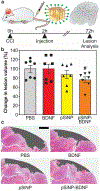Porous Silicon Nanoparticles Targeted to the Extracellular Matrix for Therapeutic Protein Delivery in Traumatic Brain Injury
- PMID: 36017941
- PMCID: PMC9492643
- DOI: 10.1021/acs.bioconjchem.2c00305
Porous Silicon Nanoparticles Targeted to the Extracellular Matrix for Therapeutic Protein Delivery in Traumatic Brain Injury
Abstract
Traumatic brain injury (TBI) is a major cause of disability and death among children and young adults in the United States, yet there are currently no treatments that improve the long-term brain health of patients. One promising therapeutic for TBI is brain-derived neurotrophic factor (BDNF), a protein that promotes neurogenesis and neuron survival. However, outstanding challenges to the systemic delivery of BDNF are its instability in blood, poor transport into the brain, and short half-life in circulation and brain tissue. Here, BDNF is encapsulated into an engineered, biodegradable porous silicon nanoparticle (pSiNP) in order to deliver bioactive BDNF to injured brain tissue after TBI. The pSiNP carrier is modified with the targeting ligand CAQK, a peptide that binds to extracellular matrix components upregulated after TBI. The protein cargo retains bioactivity after release from the pSiNP carrier, and systemic administration of the CAQK-modified pSiNPs results in effective delivery of the protein cargo to injured brain regions in a mouse model of TBI. When administered after injury, the CAQK-targeted pSiNP delivery system for BDNF reduces lesion volumes compared to free BDNF, supporting the hypothesis that pSiNPs mediate therapeutic protein delivery after systemic administration to improve outcomes in TBI.
Conflict of interest statement
CONFLICT DISCLOSURE
MJS is a scientific founder (SF), member of the Board of Directors (BOD), Advisory Board (AB), Scientific Advisory Board (SAB), acts as a paid consultant (PC) or has an equity interest (EI) in the following: Aivocode, Inc (AB, EI); Bejing ITEC Technologies (SAB, PC); Cend Therapeutics (SF, BOD, EI); Illumina (EI); Matrix Technologies (EI); NanoVision Bio (SAB, EI); Pacific Integrated Energy (AB, EI); Quanterix (EI); Spinnaker Biosciences, Inc. (SF, BOD, EI); TruTag Technologies (SAB, EI); and Well-Healthcare Technologies (SAB, PC). MJS is also a Guest Professor at Zhejiang University, China. Although one or more of the grants that supported this research has been identified for conflict of interest management based on the overall scope of the project and its potential benefit to the companies listed, the research findings included in this publication may not necessarily relate to their interests. The terms of these arrangements have been reviewed and approved by the University of California, San Diego in accordance with its conflict of interest policies.
Figures




Similar articles
-
Brain-derived neurotrophic factor delivered to the brain using poly (lactide-co-glycolide) nanoparticles improves neurological and cognitive outcome in mice with traumatic brain injury.Drug Deliv. 2016 Nov;23(9):3520-3528. doi: 10.1080/10717544.2016.1199609. Epub 2016 Jul 16. Drug Deliv. 2016. PMID: 27278330
-
A peptide for targeted, systemic delivery of imaging and therapeutic compounds into acute brain injuries.Nat Commun. 2016 Jun 28;7:11980. doi: 10.1038/ncomms11980. Nat Commun. 2016. PMID: 27351915 Free PMC article.
-
Targeted delivery of polypeptide nanoparticle for treatment of traumatic brain injury.Int J Nanomedicine. 2019 May 31;14:4059-4069. doi: 10.2147/IJN.S202353. eCollection 2019. Int J Nanomedicine. 2019. PMID: 31213815 Free PMC article.
-
Photoluminescent and biodegradable porous silicon nanoparticles for biomedical imaging.J Mater Chem B. 2019 Nov 7;7(41):6271-6292. doi: 10.1039/c9tb01042d. Epub 2019 Aug 8. J Mater Chem B. 2019. PMID: 31393507 Review.
-
Growth factors and their peptide mimetics for treatment of traumatic brain injury.Bioorg Med Chem. 2023 Jul 15;90:117368. doi: 10.1016/j.bmc.2023.117368. Epub 2023 Jun 10. Bioorg Med Chem. 2023. PMID: 37331175 Review.
Cited by
-
Nanomaterial payload delivery to central nervous system glia for neural protection and repair.Front Cell Neurosci. 2023 Oct 24;17:1266019. doi: 10.3389/fncel.2023.1266019. eCollection 2023. Front Cell Neurosci. 2023. PMID: 37941607 Free PMC article. Review.
-
Systematic Review of Peptide CAQK: Properties, Applications, and Outcomes.Int J Mol Sci. 2024 Oct 12;25(20):10990. doi: 10.3390/ijms252010990. Int J Mol Sci. 2024. PMID: 39456774 Free PMC article.
-
Traumatic brain injury: Bridging pathophysiological insights and precision treatment strategies.Neural Regen Res. 2026 Mar 1;21(3):887-907. doi: 10.4103/NRR.NRR-D-24-01398. Epub 2025 Mar 25. Neural Regen Res. 2026. PMID: 40145994 Free PMC article.
-
Overcoming Cytosolic Delivery Barriers of Proteins Using Denatured Protein-Conjugated Mesoporous Silica Nanoparticles.ACS Appl Mater Interfaces. 2023 Jan 11;15(1):432-451. doi: 10.1021/acsami.2c17544. Epub 2022 Dec 23. ACS Appl Mater Interfaces. 2023. PMID: 36562665 Free PMC article.
-
Applications of hydrogels and nanoparticles in the treatment of traumatic brain injury.Front Bioeng Biotechnol. 2025 Jan 6;12:1515164. doi: 10.3389/fbioe.2024.1515164. eCollection 2024. Front Bioeng Biotechnol. 2025. PMID: 39834632 Free PMC article. Review.

